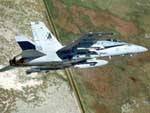US Warplanes Strike Radar Site in Southern IraqThe second strike in less than a week was conducted at about 8:15 am EDT at an-Nasiriyah, about 175 miles southeast of Baghdad, and came on the heels of Defense Secretary Donald Rumsfeld's assertion that Iraq had sharply improved its air defense. ``Coalition aircraft struck a surface-to-air missile site near an-Nasiriyah,'' said Pentagon spokesman Rear Adm. Craig Quigley. He described the target as ``another element in the Iraqi integrated air defense system that had been very active in threatening coalition air crews.'' The Pentagon has said the Iraqi military has become more aggressive recently in trying to shoot down US and British planes patrolling the ``no-fly'' zones in southern and northern Iraq. Raids by US and British planes have targeted Baghdad's increasingly sophisticated anti-aircraft network. A defense official, speaking on condition of anonymity, said a few US Air Force F-16 fighter jets used precision-guided weapons to target a single site, in a strike that was on a smaller scale than last week's bombardment. 'DAMAGE ASSESSMENT' UNDER WAYPrecision-guided weapons include missiles and bombs that are guided to their targets by satellites.A damage assessment was under way of Tuesday's target, which was a ``fire-control'' radar that provides information used in the firing of surface-to-air missiles, defense officials said. In Baghdad, a spokesman for the Iraqi air defense division said that there had been a Western air attack on ``infrastructure facilities'' in Missan province, 225 miles southeast of Baghdad. He gave no details about whether there were any casualties. Asked about the apparent discrepancy with the location cited by Iraq, Quigley said: ``We're not 50 miles off. This was the site that we intended to hit.'' Tuesday's strike followed a more severe bombardment on Friday when dozens of US and British warplanes struck three air defense sites in southern Iraq. That followed a strike on targets in northern Iraq earlier last week. Asked to assess Friday's raid, Quigley said, ``I will just say that on balance we were very pleased with the results.'' While no Western aircraft have been shot down by Iraq, Rumsfeld said recently Iraq was improving its air defenses ''both quantitatively and qualitatively'' with fiber-optic communications cabling. US officials earlier this year said Chinese technicians were helping Iraq lay fiber-optic cables to integrate its air defenses. Pentagon officials say the Iraqi military came close to hitting a high-altitude US U-2 spy plane with a missile on July 24. Baghdad has denied firing at the plane, saying US officials wanted a pretext for a military attack on Iraq. Quigley said he did not know if Tuesday's target had anything to do with the missile fired at the U-2. ``If we can degrade the capability to lessen the risk to coalition aircrews, that is, indeed, the goal,'' he said. US Central Command said Tuesday's strike was conducted ''in response to recent Iraqi hostile threats against coalition aircraft monitoring the southern no-fly zone.'' Since the 1991 Gulf War, US and British planes have regularly patrolled ``no-fly'' zones in southern and northern Iraq, which are not recognized by Baghdad. Iraq was banned from using all aircraft in the zones set up by Western powers to protect minority Kurds and Shi'ites. |
| People's Daily Online --- http://english.peopledaily.com.cn/ |
